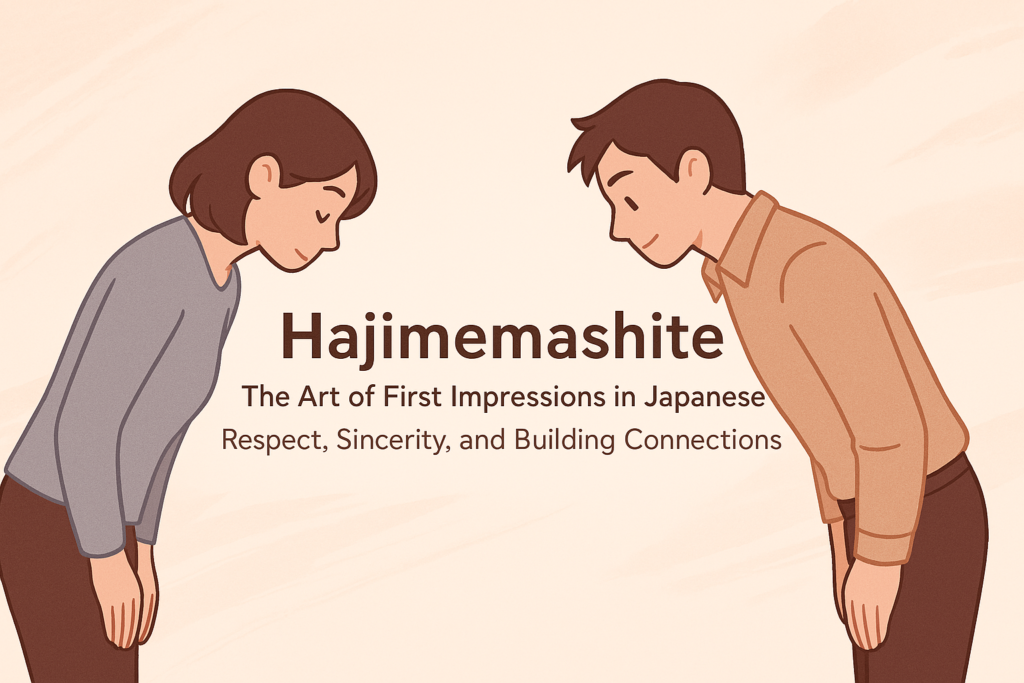Have you ever wondered how to make a great first impression in Japanese? Whether you’re preparing for a trip to Japan, meeting Japanese colleagues, or simply expanding your language skills, mastering the art of Japanese introduction (自己紹介, jikoshōkai) is your gateway to meaningful connections in Japanese culture.
The Essentials of Japanese Self-Introduction
When meeting someone new in Japan, your introduction follows a simple yet meaningful structure. Rather than complex phrases, Japanese introductions rely on three key expressions that convey respect and establish a connection.
The three fundamental phrases for any Japanese introduction are:
- Hajimemashite (はじめまして) – “Nice to meet you”
- [Your name] desu ([Your name] です) – “I am [your name]”
- Yoroshiku onegaishimasu (よろしくお願いします) – “Please treat me well/I look forward to our relationship”
These three expressions, when used together, create a complete and polite Japanese introduction that works in almost any situation. What makes this approach particularly effective is its simplicity combined with cultural appropriateness.
Breaking Down Each Phrase
Hajimemashite (はじめまして)
This opening greeting derives from “hajimete” meaning “for the first time.” It’s the perfect conversation starter when meeting someone new and works regardless of the other person’s age or social status. Unlike “hello” or “hi,” hajimemashite specifically acknowledges the first meeting between two people.
Stating Your Name
The most straightforward way to introduce yourself is “[name] desu.” This simple construction translates to “I am [name].” Notice there’s no word for “I” or “my” in this phrase—Japanese often omits personal pronouns when they’re understood from context.
For more formal situations, you might use “[name] to mōshimasu” ([name] と申します), which conveys your name in a more humble manner.
Yoroshiku onegaishimasu (よろしくお願いします)
This versatile expression concludes your introduction and establishes goodwill for your future relationship. While difficult to translate precisely, it essentially asks for the other person’s goodwill and indicates your interest in a positive relationship.
Expanding Your Japanese Introduction
Once you’re comfortable with the basics, you can enhance your Japanese introduction by adding more personal information:
Nationality and Origin
Share where you’re from using one of these patterns:
- “[Country] jin desu” ([Country]人です) – “I am [nationality]” Example: “Amerikajin desu” (アメリカ人です) – “I am American”
- “Shusshin wa [place] desu” (出身は[place]です) – “I’m from [place]” Example: “Shusshin wa Nyū Yōku desu” (出身はニューヨークです) – “I’m from New York”
Occupation
Add your profession with:
- “[Occupation] desu” ([Occupation]です) – “I am a/an [occupation]” Example: “Gakusei desu” (学生です) – “I am a student”
Hobbies and Interests
Mention what you enjoy with:
- “Shumi wa [hobby] desu” (趣味は[hobby]です) – “My hobby is [hobby]” Example: “Shumi wa ryōri desu” (趣味は料理です) – “My hobby is cooking”
Want to explore Japan’s culture?
Discover Japan’s rich culture, traditions, and hidden gems with our expertly crafted guides. Get insider tips on travel, food, and history. All for free!
Cultural Etiquette in Japanese Introductions
When introducing yourself in Japanese, nonverbal communication is just as important as the words you say.
The Art of Bowing
Bowing (お辞儀, ojigi) accompanies verbal introductions in Japan. While there are many nuances to proper bowing, as a beginner, focus on these key points:
- Maintain a straight back
- Bow from the waist at approximately a 15-degree angle for casual introductions
- Keep your hands at your sides
- Avoid talking while bowing
- Match the depth and duration of your conversation partner’s bow when responding
Business Card Exchange (名刺交換, meishi kōkan)
In professional settings, business card exchange follows specific etiquette:
- Present your card with both hands, information facing the recipient
- Receive cards with both hands and a slight bow
- Read the card before putting it away
- Keep received cards visible during your conversation
As noted in our article “Minasan Meaning: How to Address Groups Politely,” knowing how to navigate group introductions also requires understanding proper forms of address.
Common Mistakes to Avoid in Japanese Introductions
Even with the best intentions, some common pitfalls can undermine your Japanese introduction:
- Asking “How are you?” – Unlike in English, asking “Genki desu ka?” to someone you’ve just met can seem too direct in Japanese culture.
- Excessive bowing – Continuous, multiple bows can appear awkward or insincere.
- Informal language with seniors – Using casual forms with people older than you or in positions of authority can be considered disrespectful.
- Physical contact – Handshakes are becoming more common in international settings, but traditionally, physical contact during introductions is minimal in Japan.
Japanese Introduction Response Phrases
When someone introduces themselves to you, knowing how to respond appropriately is crucial:
- Kochirakoso yoroshiku onegaishimasu (こちらこそよろしくお願いします) – “Likewise, pleased to meet you”
- Oai dekite ureshii desu (お会いできて嬉しいです) – “I’m happy to meet you”
As we explained in our guide “How to Use So Desu Ka Correctly in Conversations,” conversation flow in Japanese relies heavily on appropriate responses that acknowledge what has been said.
Q&A: Common Questions About Japanese Introductions
What is the most important phrase in a Japanese introduction?
The most important phrase in a Japanese introduction is “Yoroshiku onegaishimasu,” which establishes goodwill for your future relationship.
Should I bow when introducing myself in Japanese?
Yes, a slight bow typically accompanies a Japanese introduction, showing respect and proper etiquette.
Can I use “Watashi wa” before my name in a Japanese introduction?
While grammatically correct, native speakers often omit “Watashi wa” when introducing themselves, making “[Name] desu” the more natural choice.
How do I introduce myself in a business setting in Japan?
In business settings, use more formal language like “[Name] to mōshimasu” and be prepared to exchange business cards with proper etiquette.
Ready to Take Your Japanese Learning Further?
Mastering Japanese introductions is just the beginning of your language journey. If you’re excited to develop your skills further, our comprehensive Learn Japanese resources offer free guides to help you progress from beginner to confident speaker.
Understanding proper introductions in Japanese opens doors to meaningful connections and shows respect for Japanese culture. By mastering these essential phrases and cultural practices, you’ll make a positive impression that sets the foundation for all your Japanese interactions.
Remember, a good Japanese introduction isn’t just about the words—it’s about conveying sincerity and respect from your first hajimemashite to your final yoroshiku onegaishimasu.Retry
Claude does not have internet access. Links provided may not be accurate or up to date.
Love Japan? Stay in the Loop!
Get the best of Japan straight to your inbox: language, culture & travel insights!




